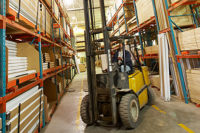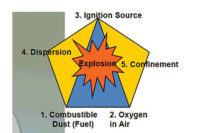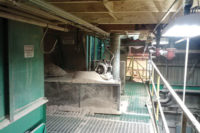High cost of noncompliance
In addition to loss of life, failure to comply with standards means serious OSHA fines can be levied against businesses. Let’s review these important NFPA standards:
- NFPA 654 cites that immediate cleaning may be warranted when dust levels accumulate to only 1/32" (0.8 mm). (That’s the size of a paper clip!)
- The same document states that if that accumulation covers 5 percent of the building’s floor, a hazardous condition can exist.
- Dust accumulation on walls and overhead beams, conduits, pipes and joists, etc. also contributes dramatically to create a hazardous condition, and must be considered when estimating the dust load of a room.
The U.S. government also has criminalized lack of compliance when disaster strikes. The seriousness with which these organizations take compliance was highlighted at the end of 2013. As a result of a combustible dust explosion that killed two men in 2010, the president of Black Mag LLC, a manufacturer of gun powder substitute based in New Hampshire, was convicted of criminal violation of OSHA regulations. His punishment: A $10,000 personal penalty and a prison sentence up to 20 years for his role in 16 willful safety violations. His company had to pay $1.2 million, which put it out of business.
Clearly, we have to take this safety issue seriously. We cannot afford to risk people’s lives, nor can we afford the penalties — both criminal and civil — of doing nothing. But the fact of the matter is that there is a cost to any solution, which then hits the bottom line of the business.
This article is the first in a series of articles ISHN will publish throughout 2014 to provide a more in-depth review of the costs associated with the different ways to eliminate the risks of combustible dust. We’ll start with what has been done historically.
What is a managed approach?
A managed approach is essentially manual housekeeping. In this scenario, third-party cleaning services or plant employees remove accumulated dust and fiber intermittently. The interval of cleaning depends on the processing and the particles — the more dust generated, the more frequent the cleaning.
No doubt you’ve seen this approach in action. A person gets up on a ladder (worst case scenario) or on a scissor lift and starts removing the dust/fiber from overhead structures and processing equipment. Once the dust settles on the floor, it is then removed from the building.
The cost of cleaning this way varies widely. A range of prices have been reported to me, including:
- Larry Baker, president of Fuzion Solution, noted that one company in the paper and pulp industry spent an average of $2.40 per square foot on manual cleaning.
- One food and beverage plant paid $100,000 per cleaning.
- For one woodworking facility, the cost of cleaning was $0.40 per square foot.
- One small mill reported spending $10,000 monthly on manual cleaning.
So the cost is there, at whatever level. Now the question is — is that a good value for the price?
Benefits of a managed approach
A managed approach is the status quo across all industries. Before technological advances were made, manual housekeeping was the only solution.
What many people find attractive about ongoing cleaning is that there are low upfront costs. You don’t have to put down a lot of money at one time to continue either using cleaning services or using your employees to manage combustible dust.
What’s more, manual cleaning for combustible dust can even appear not to cost anything, as it is absorbed in its operational budget. It costs, of course, but that cost is not clearly evident, which is appealing to some companies’ budgeting process. It just seems like less of a hassle.
In addition, manual cleaning does not necessitate a strategic plan. If companies do not have a capital investment plan, it can be extremely difficult to allocate the funds needed for an engineered approach — be it barrier air technology (using clean fans), vacuuming, filtration, etc. Even if the engineered solutions can show amortization of the installation, some companies can’t secure the initial investment needed. Within this scenario, ongoing manual cleaning is appealing.
Weaknesses of a managed approach
One issue to consider with manual cleaning is that the level of clean in the facility varies according to the proximity to the scheduled cleaning times. It stands to reason that a facility is cleaner right after it has been cleaned; if it is the day before it is scheduled to be cleaned, the facility is going to have accumulated combustible dust. At times, depending on the interval of cleaning, the dust levels may actually exceed OSHA regulations.
With a managed approach, there is also increased risk to personnel while cleaning overhead areas. There is no way to avoid people cleaning at high elevations using the scissor lift, and extending their reach to all the lights, ducts, joists, etc. that have to be kept clean. Safety of employees or third-party cleaning services needs to be a factor in the decision to clean manually.
Another safety issue applies to Class 2 hazardous location designations. This is an important, but often overlooked, aspect of containing combustible dust, and is addressed in NFPA 499 6.2.3.1: “The classification depends both on the presence of dust clouds and on the presence of hazardous accumulations of dust in the layer form.” It continues to state in A.6.3.2: “Based on these thicknesses of dust, good housekeeping can determine the difference between … classification of Div. 2 and unclassified.”
Can a managed approach be considered good housekeeping? Because of its cyclical nature as stated earlier, I don’t believe that manual cleaning is a solution for this problem.
Will a managed solution work best for your business?
There are a range of business scenarios where a managed approach is the most cost- effective solution to combustible dust and fiber. Take a look at this checklist to see if any of these criteria fit your business:
- You have a plant that is less than 2,000 square feet.
- Your overhead roof structures are less than 14 feet and are convenient to reach.
- You have an owner who is willing to clean it him/herself.
- Your processes (whatever they may be to generate your product) do not generate more than 1/16-inch dust in a year.
- Your facility operates just 8 hours a day, 5 days a week and you can clean over the weekend without loss of production.
- Your building allows access to all areas where dust particulates can accumulate (e.g. no equipment in the way to reach overhead structure).
We all know that business dictates that its success is counted in terms of return on investment (ROI). In other words, the cost of doing business has to be less than the revenues generated, or the company cannot survive. But the cost of combustible dust is not a simple spreadsheet equation, because the safety of associates is at stake. You can’t put a price on that.



